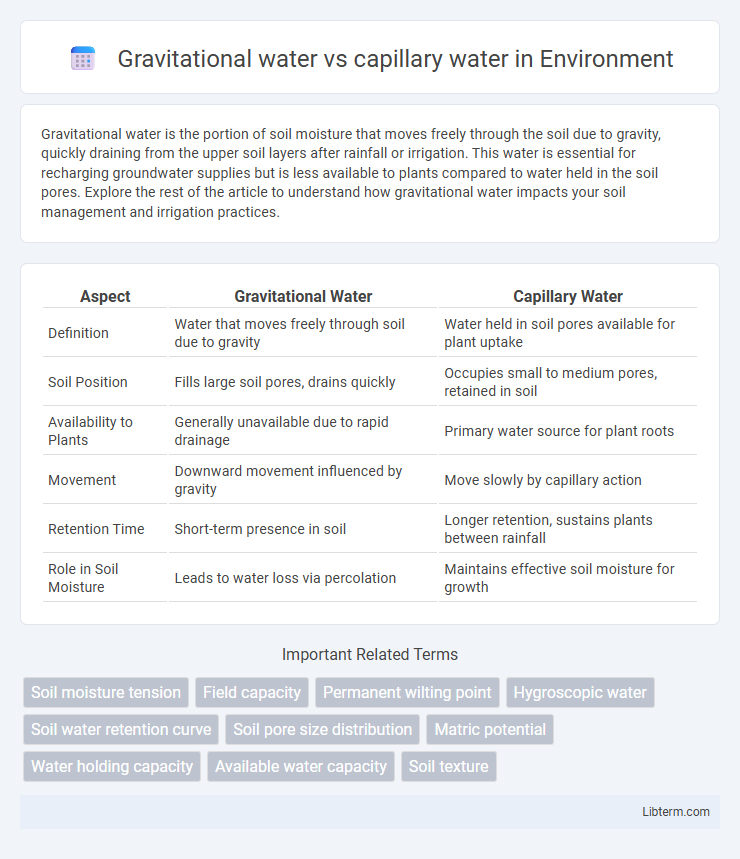Gravitational water is the portion of soil moisture that moves freely through the soil due to gravity, quickly draining from the upper soil layers after rainfall or irrigation. This water is essential for recharging groundwater supplies but is less available to plants compared to water held in the soil pores. Explore the rest of the article to understand how gravitational water impacts your soil management and irrigation practices.
Table of Comparison
| Aspect | Gravitational Water | Capillary Water |
|---|---|---|
| Definition | Water that moves freely through soil due to gravity | Water held in soil pores available for plant uptake |
| Soil Position | Fills large soil pores, drains quickly | Occupies small to medium pores, retained in soil |
| Availability to Plants | Generally unavailable due to rapid drainage | Primary water source for plant roots |
| Movement | Downward movement influenced by gravity | Move slowly by capillary action |
| Retention Time | Short-term presence in soil | Longer retention, sustains plants between rainfall |
| Role in Soil Moisture | Leads to water loss via percolation | Maintains effective soil moisture for growth |
Introduction to Soil Water Types
Gravitational water refers to the water in soil that moves downward due to gravity, filling large pores and draining quickly after rainfall or irrigation. Capillary water is retained in the small pores between soil particles and is available for plant uptake, providing essential moisture for growth. Understanding the distinction between these two soil water types is crucial for effective irrigation management and optimizing plant water availability.
Defining Gravitational Water
Gravitational water refers to the water in soil that moves downward through the soil profile due to gravity and is not held by soil particles, making it readily available for drainage and less accessible to plants. In contrast, capillary water is retained in the small pores of soil and held by surface tension, providing an essential moisture source for plant roots. Understanding the distinction between gravitational and capillary water is crucial for effective irrigation management and soil moisture retention strategies.
Understanding Capillary Water
Capillary water is the moisture held in soil pores by surface tension, making it readily available for plant roots to absorb. Unlike gravitational water, which moves freely through larger soil pores due to gravity and drains quickly, capillary water remains suspended, providing a steady water supply essential for plant growth. Its retention mechanisms and availability directly influence soil water holding capacity and irrigation efficiency in agriculture.
Key Differences Between Gravitational and Capillary Water
Gravitational water moves freely through soil pores due to gravity, typically draining quickly and not readily available to plants. Capillary water is held in small soil pores by surface tension, making it accessible for plant roots to absorb. The key difference lies in water availability and movement; gravitational water drains rapidly, while capillary water remains in the root zone, sustaining plant growth.
Role in Soil Moisture Dynamics
Gravitational water moves quickly through soil due to gravity, primarily occupying macropores and affecting deep percolation and drainage, which reduces water availability to plants. Capillary water is held in micropores by surface tension, serving as the main water source accessible to plant roots for nutrient uptake and growth. Understanding the balance between gravitational and capillary water is essential for managing irrigation efficiency and optimizing soil moisture retention in agricultural practices.
Movement and Retention in Soil
Gravitational water moves rapidly through soil pores due to gravity, quickly draining from saturated soil and contributing minimally to plant water availability. Capillary water is retained in small soil pores by surface tension, moving slowly and serving as the primary water source accessible to plant roots. Soil texture and pore size significantly influence the balance between gravitational and capillary water retention and movement.
Importance for Plant Uptake
Gravitational water quickly drains through soil pores, making it temporarily available but largely inaccessible for plant roots, whereas capillary water is held in the soil's micropores and serves as the primary source of moisture absorbed by plants. The retention of capillary water within the root zone is crucial for sustaining plant hydration and nutrient uptake during growth cycles. Efficient water management in agriculture emphasizes maximizing capillary water availability to improve plant health and crop yield.
Impact on Irrigation Efficiency
Gravitational water rapidly drains through soil pores, reducing the water available for crops and decreasing irrigation efficiency by causing nutrient leaching and water wastage. Capillary water, retained in the root zone, directly supports plant uptake, enhancing irrigation efficiency by maintaining optimal moisture levels for growth. Managing soil structure and irrigation timing to maximize capillary water retention is crucial for improving water use efficiency in agriculture.
Factors Influencing Water Availability
Gravitational water moves through large soil pores under the influence of gravity, making it temporarily available to plants but quickly draining away, while capillary water is held in smaller pores and provides the primary source of moisture for plant roots. Soil texture, pore size distribution, and land slope significantly influence the availability of these water types, with sandy soils favoring rapid gravitational water movement and clay soils retaining more capillary water. Soil compaction and organic matter content also play crucial roles by altering pore structure, thereby affecting water retention and accessibility for plant uptake.
Conclusion: Balancing Gravitational and Capillary Water in Agriculture
Balancing gravitational and capillary water is crucial for optimal soil moisture management in agriculture, as gravitational water rapidly drains and replenishes soil while capillary water retains moisture accessible to plant roots. Effective irrigation strategies enhance capillary water availability without causing excessive gravitational water loss, improving crop yield and water use efficiency. Understanding soil texture and structure further guides water retention practices, ensuring sustainable and productive agricultural systems.
Gravitational water Infographic

 libterm.com
libterm.com